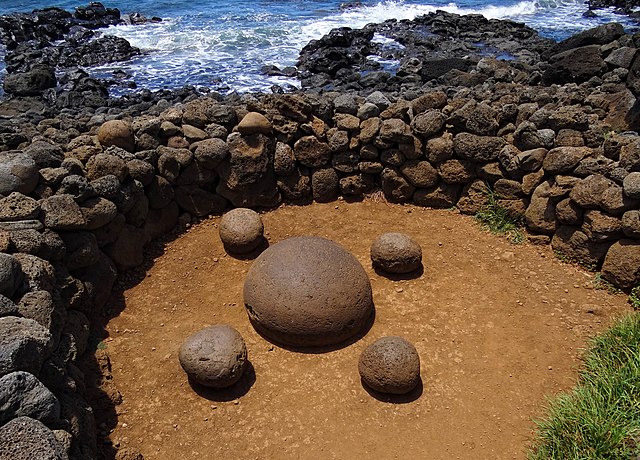Ahu Te Pito Kura is the largest ahu (ceremonial platform) on Easter Island. It features the largest moai (monolithic human figures) ever erected on the island. The site symbolizes the island’s rich cultural heritage and the engineering prowess of its ancient inhabitants. The moai at Ahu Te Pito Kura, named “Paro,” stands out for its immense size and the mystery surrounding its toppling. The site also includes a spherical stone believed to represent the “navel of the world,” adding to its cultural significance.
Get your dose of History via Email
Historical Background of Ahu Te Pito Kura
The discovery of Ahu Te Pito Kura dates back to the early European explorers who visited Easter Island. They documented the site’s existence and the fallen moai. The Rapa Nui people, the island’s original inhabitants, built this ahu and moai. The exact date of construction remains uncertain, but it likely occurred during the island’s moai-building heyday. The site later became uninhabited, with the moai toppling over in the past centuries. Ahu Te Pito Kura has not been the scene of major historical events but remains a testament to the Rapa Nui culture.
Archaeologists believe the Rapa Nui people constructed Ahu Te Pito Kura. However, the exact individuals or groups responsible for its creation are unknown. The Rapa Nui civilization is renowned for its impressive moai, and Ahu Te Pito Kura showcases their skill. The site’s construction likely involved a large community effort, with the moai’s transportation and erection being significant feats.
After its initial use, Ahu Te Pito Kura did not see continuous habitation or significant redevelopment. The site’s religious or ceremonial importance declined as the Rapa Nui society faced ecological challenges and social upheaval. The moai “Paro” eventually fell, possibly due to seismic activity or deliberate action by the island’s inhabitants.
Ahu Te Pito Kura holds a place in the island’s history, not for events that occurred there but for its representation of the Rapa Nui’s cultural zenith. The site’s construction and the moai’s erection are historical achievements that reflect the society’s organization, religious beliefs, and artistic expression.
The site’s discovery and documentation by Europeans have allowed for its study and preservation. Archaeological efforts have provided insights into the Rapa Nui’s engineering techniques and societal structure. Ahu Te Pito Kura continues to be an essential part of Easter Island’s historical narrative and a focus for ongoing research and conservation efforts.
About Ahu Te Pito Kura
Ahu Te Pito Kura is a significant archaeological site on Easter Island, known for its massive moai named “Paro.” The moai, carved from volcanic tuff, stands at about 10 meters (33 feet) tall and weighs approximately 82 tons. It is the largest moai ever erected on an ahu and exemplifies the Rapa Nui’s stone-carving expertise.
The ahu itself is a rectangular stone platform, a common feature in Rapa Nui ceremonial architecture. It served as a base for the moai and a focal point for ceremonies. The construction of the ahu involved carefully fitting large basalt slabs without the use of mortar, showcasing the builders’ precision and skill.
Adjacent to the ahu is a large, polished spherical stone known as Te Pito o Te Henua, or “The Navel of the World.” This stone is said to possess mana, a spiritual force, and is surrounded by four smaller stones that are positioned cardinal points. The significance of this stone adds a layer of mystery and spiritual importance to the site.
The moai “Paro” once stood on the ahu, overlooking the island with its back to the sea. Its features, like other moai, include a heavy brow, elongated ears, and a prominent nose. The moai’s toppled position allows visitors to observe the intricate carvings that would have faced the sky when it stood erect.
The site’s construction methods reflect the Rapa Nui’s advanced understanding of engineering and their ability to mobilize resources. The transportation of the moai from the quarry at Rano Raraku to Ahu Te Pito Kura, over rough terrain, remains an impressive feat. The methods used, possibly involving wooden sledges or rollers, are still studied and debated by researchers.
Theories and Interpretations
Several theories exist about the purpose and significance of Ahu Te Pito Kura. Most agree that it served a ceremonial or religious function, as with other ahu and moai on the island. The site may have been a place of ancestor worship, with the moai representing deified ancestors watching over the living community.
The mystery of the moai’s toppling has led to various interpretations. Some suggest it was the result of clan wars, where rival groups would topple each other’s statues. Others believe natural disasters, such as earthquakes, could have caused the moai to fall. The true reason remains a subject of speculation.
The presence of Te Pito o Te Henua, the “Navel of the World,” has inspired spiritual interpretations. It is believed to symbolize the creation of the island or the center of spiritual power. This stone’s significance to the Rapa Nui and its exact role in their culture are still not fully understood.
Dating of the site has been carried out using radiocarbon methods, which suggest the ahu and moai were constructed during the peak of the Rapa Nui’s moai-building period. However, the exact date of the moai “Paro’s” toppling is harder to determine, with estimates ranging over several centuries.
Archaeological excavations and studies have provided some answers but also raised new questions. The interpretations of Ahu Te Pito Kura’s purpose and the events leading to its current state are continually refined as new evidence comes to light and as researchers apply different analytical techniques.
At a glance
Country: Chile (Easter Island)
Civilization: Rapa Nui
Age: Estimated construction around 1200-1600 AD

